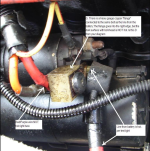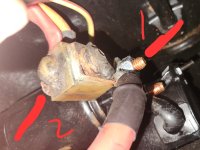Hey all, I've been chasing a problem and have it isolated. Maybe you can fet me over the hump.
98 350 Mag Mpi B3 set up.
new batteries fully charged, new battery cables, starter, starter solenoid, alternator bla bla bla.
I have 11.6/11.7V at the ignition switch, and thus to the solenoid, circuit breaker, alternator and starter...low voltage while starting isn't fun. The Volt meter barely reads anything on the dash till the engine starts, then it, and a tester at the battery will read only 12.6/12.7V.
All other 12V connections read perfect. If I jump a wire from 12v source to the ignition switch all problems disappear. Batteries reading over 13 to 14V when running, the dash volt meter reads 12v with the key on...
So, what feeds the ignition switch, and why would just this have a low voltage issue Just in the starting circuit? Suggestions?
Dan
98 350 Mag Mpi B3 set up.
new batteries fully charged, new battery cables, starter, starter solenoid, alternator bla bla bla.
I have 11.6/11.7V at the ignition switch, and thus to the solenoid, circuit breaker, alternator and starter...low voltage while starting isn't fun. The Volt meter barely reads anything on the dash till the engine starts, then it, and a tester at the battery will read only 12.6/12.7V.
All other 12V connections read perfect. If I jump a wire from 12v source to the ignition switch all problems disappear. Batteries reading over 13 to 14V when running, the dash volt meter reads 12v with the key on...
So, what feeds the ignition switch, and why would just this have a low voltage issue Just in the starting circuit? Suggestions?
Dan























